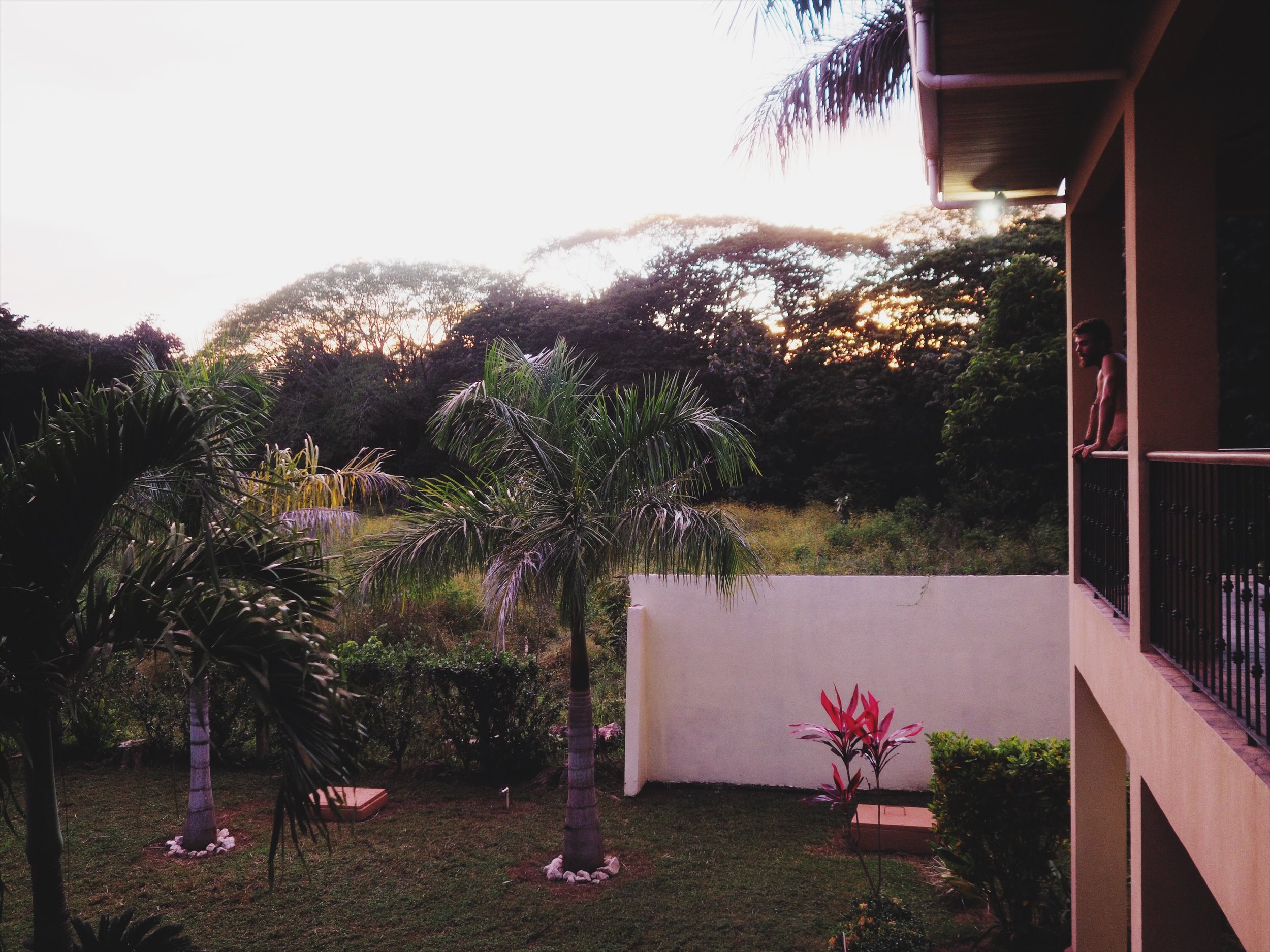Day 189-206 Costa Rica's Nicoya Peninsula
COSTA RICA'S NICOYA PENINSULA
DISTANCE: 211 MILES | ELEVATION GAIN: 12,000 FEET+ | 75% UNPAVED
RIVER CROSSINGS: 5
PROS: Best beach camping in Central America, clean waters, friendly locals
CONS: Rains make river crossings impassable and roads more rutty at times, some parts (Samara, Playa Tambor) are very touristy
BEST QUIET PLAYAS: Bahia de los Piratas, Playa Arellanas, Playa Garza
Our stop at immigration was a quick and easy process. Costa Rica charges tourists $20 without proof of departure, but with our card and website we were waved through without having to pay. "We're going to Argentina," we say, if not to tell others, at least to affirm it for ourselves. No two ways about it.
The experience was particularly strange given that less than five minutes after leaving the immigration office, we came upon a massive West African and Haitian migrant camp with over a thousand refugees, settled on the border hoping for passage into Nicaragua. We stopped for a moment and took it in, shocked and horrified at what we were seeing. The camps were ramshackled homes made of heavyweight plastic tarps, garbage bags and sticks. Some were fortunate enough to have a tent. We felt our privilege standing there with our expensive mountain bikes, all our gear and US passports. What took us less than an hour at the border as American citizens, these people were waiting years for. We both wanted to photograph what we were seeing, but were unable to bring ourselves to do so. The photo pictured above right was taken by Alvaro Sanchez for the local paper, Tico Times. If you want to read more about the immigrants from Haiti and West Africa who are currently settled on the border at Peñas Blancas, Guanacaste, Costa Rica, check out this great NPR article.
When we first started planning our route through Costa Rica, we thought we might take the PanAmericana throughout the country, getting through it as quickly as possible. We knew it was the most expensive country in Central America and we've been traveling on a tight budget, so we were skeptical. We heard that the Nicoya Peninsula in the north was worth checking out, and found a wonderful route on Bikepacking.com that took us off the main highway. We were so happy we did, because the free nightly beach camping in remote areas allowed us to save a lot of money and enjoy some of the best wild camping in all of Central America. If you are traveling by bicycle through Central America, we highly recommend getting off the beaten path and pedaling the Nicoya Peninsula, as it is filled with small dirt roads and tracks waiting to be explored by bicycle. Despite this stretch only being about 200 miles or so, we decided to give ourselves two weeks -- more than enough time to enjoy it slowly and squeeze in a few days off. This was our longest continuous dirt road stretch since Oaxaca and we were really excited to explore the wild jungles of the Nicoya Peninsula that we heard so much about.
Costa Rica’s paved roads are highly trafficked and drivers are not the most courteous to cyclists. After crossing the border and camping at a pizza place near the border town, we pedaled the next day through the city of Liberia, where we tuned up our bikes, and quickly pedaled on, linking up with dirt roads that took us as far south as Playa Manzanillo. Once on dirt roads, we immediately breathed a sigh of relief. The roads became extremely quiet. The sigh of relief quickly turned into heavy huffing and puffing, with steep climbs greeting us as we made our way closer to the hilly coast. Out of nowhere, we heard rustling in the trees above us and saw a family of capuchin monkeys! Despite our best efforts to make camp on the beach that night, we settled for a campsite high in the cloud forest as the sun was setting, under a large dilapidated Jurassic Park-style gate, only a few miles away from the beach. Not bad for our first day on the Nicoya!
We awoke to a strange noise -- deep howling in the cloud forest around us -- howler monkeys!
The next morning we descended to the small town of Puerto Portrero, passing by the touristy beaches of Flamingo and Brasilito, before making our way to a tiny bay that we spotted on the map, near Bahia de los Piratas. We cycled through a sandy trail, eventually pushing our bikes across an empty beach to find the most wonderful campsite, where we had the entire cove to ourselves. It remains one of the top campsites of our entire trip! We met two friendly local fishermen who gave us a few fish for dinner, which we cooked over our BioLite CampStove and enjoyed with a slice of lime.
We pedaled on from there into Bahia de los Piratas where we had some challenging climbs and descents on steep, rutty roads. It was hot and exhausting but a lot of fun. Mehedi picked up some guanacaste and pochote wood from an Argentinian woodworker, which he proceeded to carve into beautiful cucharitas (little spoons). We encountered dozens of howler monkeys on the road. Towards the end of the day we pulled onto a small beach just past Playa Avellanas, where we found a sweet little campsite next to an abandoned beach shack. We spent the evening collecting beautiful, worn-down shells that had formed perfect circles with tiny holes in the middle. Future art project, for sure. We watched the sunset and enjoyed a quiet, beautiful evening after another wonderful day.
Another day on the Nicoya Peninsula, whether it's mud or rivers or rain, we are ready for the day's challenges!
Playa Avellanas tidepools
River crossings are the daily norm
The next day we had another gorgeous but challenging ride, rewarded by more howler monkeys and another great beach campsite near Playa Santa Cruz. A family living just up the way gave us a bag of about 30 mangoes from their trees. When we arrived, we set camp among the palm-tree lined beach and took a nice, long swim in the ocean. The weather on the Nicoya has been hot, though not as hot as the rest of Central America. Daily swims after pedaling were refreshing in the clean ocean waters. We read, hammocked, and Erin played guitar while Mehedi carved spoons. Life doesn't get much better than this!
After another fantastic ride the next day (yes, more monkeys), we pedaled into the small town of Marbella. There we met Darcy at the Marbella Surf Inn, who graciously put us up at his beautiful inn for several nights. We spent the next few days resting, cleaning the bikes, enjoying A/C, working on our blog and exploring the quaint little town and beautiful beach of Marbella. It was a nice contrast to the highly trafficked beaches of Samara and Tamarindo. Marbella (“beautiful ocean” in Spanish) certainly lived up to its name. Thanks for the hospitality, Darcy!
It was time to get back on the road again, and was perhaps our hardest day of riding given the heat coupled with some good, steep climbs throughout the day. We made camp on the beach at Playa Garza, with thousands of tiny crabs. They seemed very interested in us when we started making dinner...
Mehedi crosses a crocodile river near Samara
The next day was rather eventful as we had to cross a few rivers, one of which was about three feet deep. Once we got to the other side, we stopped for a snack and watched over a dozen howler monkeys make their way through the trees above us. A local woman drove up on her four wheeler to check the river’s depth and informed us that in this river lived crocodiles. “But they’re not as hungry because it’s the wet season,” she assured us. Ignorance is bliss. In Samara we stopped at a little organic tienda, where we indulged in some incredible vegan, gluten-free chocolate cake.
We then camped at beautiful Playa Carrillo, not far from a “Beware of Crocodiles” sign. You could say we felt lucky that day.
From there we pedaled on to Playa Corazolito, nestled between palm trees overlooking the water. The beach was virtually empty as the town consisted of only a restaurant or two and a handful of houses.
Peanut butter and banana break in Punta Islita, a charming town filled with mosaic work, handicrafts and a beautiful local art gallery
One of the deeper crocodile rivers we had to pass -- this one was about three feet deep north of Playa Manzanillo
It was another eventful day for us with an enormous river crossing (keeping an eye out for crocs). We made camp on the beach above Playa Manzanillo. As we were cooking dinner, we could see and feel an enormous storm brewing over the ocean and just as dinner was ready, it began to rain very hard. We went inside our tent to feast, sweating profusely as it was not only hot outside but we had cooked up a nice, hot soup. It may sound silly to make soup almost every night in the heat of the tropics, but there’s nothing like a warm belly after a long day’s ride. It wasn’t long after we finished dinner that the storm seemed to worsen -- it was now raining cats and dogs and probably monkeys too. Lightning and thunder started closing in on us until eventually a bolt struck too close for comfort. Frightened, we sat up in the tent, prayed, hoped and wished that we’d be okay. Lightening continued to strike all around us for at least an hour. We were humbled by Mother Nature that night, to say the least. Eventually the storm passed and we were able to fall asleep.
The next morning we awoke to find everything splashed by mud from such heavy rainfall, even gear under our rain fly. We dried out, made a quick breakfast, and rode the beach at low tide to avoid linking back up with the road which would have required a lot more climbing. The beach riding was beautiful and after that lightning storm, we were just happy to make it out alive!
We stopped at a little tienda where the owner let us wash our muddy, sandy bikes. We pedaled on late into the afternoon, stopping at a delicious restaurant that served extremely hot repollo (pickled peppers & onions). From there, our dirt road turned into pavement, and we covered the entire width of the southern Nicoya Peninsula in just an hour or so. We camped near Playa Tambor that night, on the eastern side of the peninsula.
The next day we made our way to Paquera, where we hopped a ferry to Puntarenas. Not only did we survive our longest stretch on dirt, we absolutely loved it.
Looking back at the Nicoya from our ferry to the mainland










































